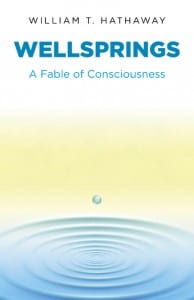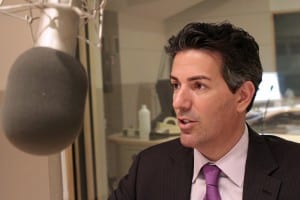Dave Foreman and the First Green Scare Case
 Dave Foreman, co-founder of Earth First!, awoke at five in the morning on May 30, 1989 to the sound of three FBI agents shouting his name in his Tucson, Arizona home. Foreman’s wife Nancy answered the door frantically and was shoved aside by brawny FBI agents as they raced toward their master bedroom where her husband was sound asleep, naked under the sheets, with plugs jammed in his ears to drown out the noise of their neighbor’s barking Doberman pincher. By the time Foreman came to, the agents were surrounding his bed, touting bulletproof vests and .357 Magnums.
Dave Foreman, co-founder of Earth First!, awoke at five in the morning on May 30, 1989 to the sound of three FBI agents shouting his name in his Tucson, Arizona home. Foreman’s wife Nancy answered the door frantically and was shoved aside by brawny FBI agents as they raced toward their master bedroom where her husband was sound asleep, naked under the sheets, with plugs jammed in his ears to drown out the noise of their neighbor’s barking Doberman pincher. By the time Foreman came to, the agents were surrounding his bed, touting bulletproof vests and .357 Magnums.
He immediately thought of the murder of Fred Hampton in Chicago, expecting to be shot in cold blood. But as Foreman put it, “Being a nice, middle-class honky male, they can’t get away with that stuff quite as easily as they could with Fred, or with all the native people on the Pine Ridge Reservation back in the early 70s.”
So instead of firing off a few rounds, they jerked a dazed Foreman from his slumber, let him pull on a pair of shorts, and hauled him outside where they threw him in the back of an unmarked vehicle. It took over six hours before Foreman even knew why he had been accosted by Federal agents.
Foreman’s arrest was the culmination of three years and two million tax dollars spent in an attempt to frame a few Earth First! activists for conspiring to damage government and private property. The FBI infiltrated Earth First! groups in several states with informants and undercover agent-provocateurs. Over 500 hours of tape recordings of meetings, events and casual conversation had been amassed. Phones had been tapped and homes broken in to. The FBI was doing their best to intimidate radical environmentalists across the country, marking them as potential threat to national security.
It was the FBI’s first case of Green Scare.
The day before Foreman was yanked from bed and lugged in to the warm Arizona morning, two so-called co-conspirators, biologist Marc Baker and antinuclear activist Mark Davis, were arrested by some 50 agents on horseback and on foot, with a helicopter hovering above as the activists stood at the base of a power line tower in the middle of desert country in Wenden, Arizona, 200 miles northwest of Foreman’s home. The next day Peg Millet, a self-described “redneck woman for wilderness,” was arrested at a nearby Planned Parenthood where she worked. Millet earlier evaded the FBI’s dragnet.
Driven to the site by an undercover FBI agent, the entire episode, as Foreman put it, was the agent’s conception. Foreman, described by the bureau as the guru and financier of the operation, was also pegged for having thought up the whole elaborate scheme, despite the fact that their evidence was thin.
Back in the 1970s the FBI issued a memo to their field offices stating that when attempting to break up dissident groups, the most effective route was to forget about hard intelligence or annoying facts. Simply make a few arrests and hold a public press conference. Charges could later be dropped. It didn’t matter; by the time the news hit the airwaves and was printed up in the local newspapers, the damage had already been done.
It was the FBI’s assertion that the action stopped by the arrests under that Arizona power line in late May, 1989, was to be a test run for a much grander plot involving Davis, Baker, Millet, and the group’s leader, Dave Foreman. The FBI charged the four with the intent to damage electrical transmission lines that lead to the Rocky Flats nuclear weapons facility in Colorado.
“The big lie that the FBI pushed at their press conference the day after the arrests was that we were a bunch of terrorists conspiring to cut the power lines into the Palo Verde and Diablo Canyon nuclear facilities in order to cause a nuclear meltdown and threaten public health and safety,” explained Foreman.
In the late 1980s the FBI launched operation THERMCON in response to an act of sabotage of the Arizona Snowbowl ski lift near Flagstaff, Arizona that occurred in October 1987, allegedly by Davis, Millet and Baker. Acting under the quirky name, Evan Mecham Eco-Terrorist International Conspiracy (EMETIC) — the eco-saboteurs wrecked several of the company’s ski lifts, claiming that structures were cutting in to areas of significant biological importance.
This was not the first act the group claimed responsibility for. A year prior EMETIC sent a letter declaring they were responsible for the damage at the Fairfield Snow Bowl near Flagstaff. The group’s letter also included a jovial threat to “chain the Fairfield CEO to a tree at the 10,000-foot level and feed him shrubs and roots until he understands the suicidal folly of treating the planet primarily as a tool for making money.”
The group used an acetylene torch to cut bolts from several of the lift’s support towers, making them inoperable. Upon receiving the letter, the Arizona ski resort was forced to shut down the lift in order to repair the damages, which rang up to over $50,000.
But the big allegations heaved at these eco-saboteurs wasn’t for dislodging a few bolts at a quaint ski resort in the heart of the Arizona mountains, or for inconveniencing a few ski bums from their daily excursions. No, the big charges were levied at the group for allegedly plotting to disrupt the functions of the Rocky Flats nuclear facility hundreds of miles away. Ironically, at the moment of their arrests, the FBI was simultaneously looking into public health concerns due to an illegal radioactive waste leak at the nuclear power site, which led Earth First! activist Mike Roselle to quip, “ [the FBI] would have discharged its duty better by assisting in a conspiracy to cut power to Rocky Flats, instead of trying to stop one.”
***
Gerry Spence climbed into his private jet in Jackson, Wyoming estate almost immediately after he heard about the FBI arrest of Dave Foreman in Arizona. Spence had made a name for himself among environmental activists in the late-1970s for his case against energy company Kerr-McGee, when he provided legal services to the family of former employee Karen Silkwood, who died suspiciously after she challenged the company of environmental abuses at one of their most productive nuclear facilities. Silkwood, who made plutonium pellets for nuclear reactors, had been assigned by her union to investigate health and safety concerns at a Kerr-McGee plant near Crescent, Oklahoma. In her monitoring of the facility Silkwood found dozens of evident regulatory violations, including faulty respiratory equipment as well as many cases of workers being exposed to radioactive material.
Silkwood went public after the company seemingly ignored her and her union’s concerns, even going as far as to testify to the Atomic Energy Commission (AEC) about the issues, claiming that regulations were sidestepped in an attempt to up the speed of production. She also claimed that workers had been mishandling nuclear fuel rods, but the company has covered up the incidences by falsifying inspection reports.
On the night of November 13, 1974, Silkwood left a union meeting in Crescent with documents in hand to drive to Oklahoma City where she was to meet and discuss Kerr-McGee’s alleged violations with a union official and two New York Times reporters. She never made it. Silkwood’s body was found the next day in the driver’s seat of her car on the side of the road, stuck in a culvert. She was pronounced dead on the scene and no documents were found in her car.
An independent private investigation revealed that Silkwood was in full control of her vehicle when it was struck from behind and forced off to the side of the road. According to the private investigators, the steering wheel of her car was bent in a manner that showed conclusively that Silkwood was prepared for the blow of the accident as it occurred. She had not been asleep at the wheel as investigators initially thought. The coroner concluded she had not died as a result of the accident, but possibly from suffocation.
No arrests or charges were ever made. Silkwood’s children and father filed a lawsuit against Kerr-McGee on behalf of her estate. Gerry Spence was their lead attorney. An autopsy of Silkwood’s body showed extremely high levels of plutonium contamination. Lawyers for Kerr-McGee argued first that the levels found were normal, but after damning evidence to the contrary, they were forced to argue that Silkwood had likely poisoned herself.
Spence had been victorious. Kerr-McGee’s defense was caught in a series of unavoidable contradictions. Silkwood’s body was laden with poison as result of her work at the nuclear facility. In her death Spence vindicated her well-documented claims. The initial jury verdict was for the company to pay $505,000 in damages and $10,000,000 in punitive damages. Kerr-McGee appealed and drastically reduced the jury’s verdict, but the initial ruling was later upheld by the Supreme Court. On the way to a retrial the company agreed to pay $1.38 million to the Silkwood estate.
Gerry Spence was not cowed by the antics of the Kerr-McGee Corporation, and when he agreed to take on Dave Foreman’s case pro-bono, justice seemed to be on the horizon for the Earth First! activists as well.
“Picture a little guy out there hacking at a dead steel pole, an inanimate object, with a blowtorch. He’s considered a criminal,” said Spence, explaining how he planned to steer the narrative of Foreman’s pending trial. “Now see the image of a beautiful, living, 400-year-old-tree, with an inanimate object hacking away at it. This non-living thing is corporate America, but the corporate executives are not considered criminals at all.”
Like so many of the FBI charges brought against radical activists throughout the years, the case against Dave Foreman was less exciting than the investigation that led up to his arrest. The bureau had done its best to make Foreman and Earth First! out to be the most threatening activists in America.
Spence was not impressed and in fact argued as much, stating the scope of the FBI’s operation THERMCON was “very similar to the procedures the FBI used during the 1960s against dissident groups.” No doubt Spence was right. Similar to the movement disruption exemplified by COINTELPRO against Martin Luther King Jr., the Black Panthers and the American Indian Movement, the FBI’s crackdown of Earth First! in the late 1980s had many alarming parallels to the agency of old.
“Essentially what we need to understand is that the Federal Bureau of Investigation, which was formed during the Palmer Raids in 1921, was set up from the very beginning to inhibit internal political dissent. They rarely go after criminals. They’re a thought police,” said Foreman of the FBI’s motives for targeting environmentalists. “Let’s face it, that’s what the whole government is. Foreman’s first law of government reads that the purpose of the state, and all its constituent elements, is the defense of an entrenched economic elite and philosophical orthodoxy. Thankfully, there’s a corollary to that law—they aren’t always very smart and competent in carrying out their plans.”
The man who was paid to infiltrate Earth First! under the guise of THERMCON was anything but competent. Special agent Michael A. Fain, stationed in the FBI’s Phoenix office, befriended Peg Millet and begun attending Earth First! meetings in the area. Fain, who went by alias, Mike Tait, posed as a Vietnam vet who dabbled in construction and gave up booze after his military service. On more than one occasion, while wearing a wire, Fain had tried to entice members of Earth First! in different acts of vandalism. They repeatedly refused.
During pre-trial evidence discovery the defense was allowed to listen to hours of Fain’s wire-tapings, when they found that the not-so-careful agent inadvertently forgot to turn off his recorder. Fain, while having a conversation with two other agents at a Burger King after a brief meeting with Foreman, spoke about the status of his investigation, exclaiming, “I don’t really look for them to be doing a lot of hurting people… [Dave Foreman] isn’t really the guy we need to pop — I mean in terms of an actual perpetrator. This is the guy we need to pop to send a message. And that’s all we’re really doing… Uh-oh! We don’t need that on tape! Hoo boy!”
Here the FBI was, acting as if these Earth First!ers were, publicly vilifying them, while privately admitting that they posed no real threat. “[The agency is acting] as if [its] dealing with the most dangerous, violent terrorists that the country’s ever known,” explained Spence at the time. “And what we are really dealing with is ordinary, decent human beings who are trying to call the attention of America to the fact that the Earth is dying.”
The FBI’s rationale for targeting Foreman was purely political as he was one of the most prominent and well-spoken radical environmentalists of the time. Despite their claims that they were not directly targeting Earth First! or Foreman, and were instead investigating threats of sabotage of power lines that led to a nuclear power plant — their public indictment painted quite a different story.
“Mr. Foreman is the worst of the group,” Assistant U.S. Attorney Roger Dokken announced to the court. “He sneaks around in the background … I don’t like to use the analogy of a Mafia boss, but they never do anything either. They just sent their munchkins out to do it.”
But agent Michael Fain’s on-tape gaffes were simply too much for the prosecution to manage, and the case against Foreman, having been deferred almost seven years, was finally reduced in 1996 to a single misdemeanor and a meager $250 in fines. The $2 million the FBI wasted tracking Earth First! over the latter part of the 1980s had only been nominally successful. Yet the alleged ring-leader was still free. Unfortunately, the FBI may have gotten exactly what they wanted all along. Dave Foreman later stepped down as spokesman to Earth First! and inherited quite a different role in the environmental movement — one of invisibility and near silence.
Peg Millet, Mark Davis and Marc Baker were all sentenced separately in 1991 for their involvement in their group EMETIC’s acts of ecotage against the expansion of Arizona Snowbowl. Davis got 6 years and $19,821 in restitution. Millet only 3 years, with the same fine, while Baker only received 6 months and a $5,000 fine.
Little did these activists know that there capture and subsequent arraignments were only the beginning. THERMCON’s crackdown of Earth First! would prove to be a dry-run for the Federal Bureau of Investigations.
Joshua Frank is author of Left Out! How Liberals Helped Reelect George W. Bush (Common Courage Press, 2005), and along with Jeffrey St. Clair, the editor of Red State Rebels: Tales of Grassroots Resistance in the Heartland, and of Hopeless: Barack Obama and the Politics of Illusion, published by AK Press. Hopeless is now available in Kindle format. He can be reached at brickburner@gmail.com.
Jeffrey St. Clair’s latest books are Born Under a Bad Sky and Hopeless: Barack Obama and the Politics of Illusion, published by AK Press. Hopeless is now available in Kindle format. He can be reached at: sitka@comcast.net






